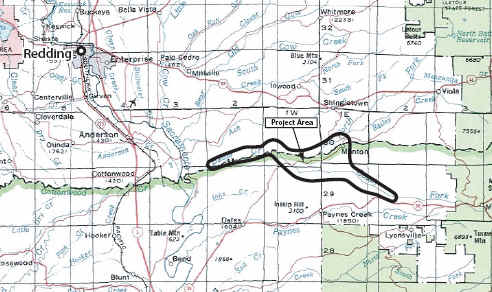|
U.S. F&WS Region 8 Press ReleaseFunding Agreements Reached for Phase 1A of the Battle Creek Project to Restore 42 Miles of Premium Salmon and Steelhead HabitatJuly 21, 2008. Funding transfer agreements were signed last week to allow for the construction of the Battle Creek Salmon and Steelhead Restoration Project. The Restoration Project will be among the largest cold water anadromous fish restoration efforts in North America. The funding agreements were reached between the Bureau of Reclamation, the California Department of Fish and Game (DFG), California Wildlife Conservation Board (WCB), California Department of Transportation (Caltrans)/Bay Area Toll Authority (BATA), Pacific Gas and Electric Company (PG&E), and U.S. Fish and Wildlife Service (FWS). The Restoration Project will restore approximately 42 miles of habitat in Battle Creek, a tributary to the Sacramento River that runs through Shasta and Tehama counties. (A project area map is available on the Web at: http://www.usbr.gov/mp/battlecreek/pdf/main/Project_location_1-05.pdf) , and will restore an additional 6 miles of habitat in its tributaries. The Restoration Project will help restore winter- and spring-run Chinook and Central Valley steelhead, all of which are critically imperiled.
These funding agreements will support the first phase (Phase 1A) of the Restoration Project, which will target the removal or retrofitting of dams within the Battle Creek Hydroelectric Project. This phase includes installing fish screens and ladders at the North Battle Creek Feeder and Eagle Canyon Diversion Dams and removing Wildcat Diversion Dam and appurtenant conveyance systems of the North Fork, installing Eagle Canyon Canal pipeline, and modifying Asbury Dam on Baldwin Creek. The Restoration Project will also increase cold water flows in Battle Creek for the benefit of the salmon and steelhead. The Battle Creek Hydroelectric Project is a small hydroelectric system owned and operated by PG&E and licensed by the Federal Energy Regulatory Commission (FERC). Despite the reduction in renewable electricity resulting from the restoration effort, PG&E fully supports this habitat restoration project and the changes to its operations that are required to ensure the success of the Restoration Project. The funding transfer agreements include $42.75 million being contributed by the State of California to implement this first phase of construction, including: --$26.82 million from DFG from Proposition 50 funds. --$9.98 million from the WCB, Proposition 50 funds vadministered through the WCB's Habitat Conservation Fund (Proposition 117). --$5.95 million from Caltrans/BATA for mitigation compliance. Additionally, $6.5 million in restoration funds will be provided from the Iron Mountain Mine Trustee Council, as facilitated by FWS. An implementation agreement associated with Phase 1A funding has also been completed between PG&E and Reclamation. It is anticipated that Phase 1A construction contracts will be awarded in 2009 and the work will be completed in 2010. Partners are currently seeking funding for the next construction phases (Phase 1B and Phase 2) so the entire project can be implemented as soon as possible. Phase 1B includes installing an Inskip Powerhouse tailrace connector and bypass on the South Fork, and Phase 2 includes installing a fish screen and ladder on Inskip diversion dam, installing a South Powerhouse tailrace connector, and removing Lower Ripley Creek Feeder, Soap Creek Feeder, Coleman and South diversion dams, and appurtenant conveyance systems (a Restoration Project Features map is available on the web at: http://www.usbr.gov/mp/battlecreek/pdf/MP-08-095_features.pdf ). Background: Pursuant to a June 1999 ?Memorandum of Understanding by and Among the National Marine Fisheries Service, U.S. Bureau of Reclamation, U.S. Fish and Wildlife Service, California Department of Fish and Game, and Pacific Gas and Electric Company for the Proposed Battle Creek Salmon and Steelhead Restoration Project? (MOU), Reclamation received $28 million Federal CALFED Bay-Delta Program Ecosystem Restoration Program (ERP) funds for project planning and implementation. In March 2005, a proposal was submitted to the California Bay-Delta Authority (CBDA), CALFED ERP, to seek additional funds. In July 2005, the Final Environmental Impact Statement/Environmental Impact Report for the Restoration Project was completed. In October 2005, CBDA decided to transfer all of its remaining Proposition 50 ERP to DFG. On March 14, 2007, DFG issued, under the California Environmental Quality Act, a Findings and Notice of Determination to provide State funding for the Restoration Project. # # # Additional Bureau media contacts: Contacts USFWS: Jim Smith, 530-527-3043 Pete Lucero, Bureau of Reclamation, 916-978-5100, plucero@mp.usbr.gov Paul Moreno, PG&E, 530-896-4290, pmmm@pge.com Jordan Traverso, Department of Fish and Game, 916-212-7352, jtraverso@dfg.ca.gov John Donnelly, Wildlife Conservation Board, 916-445-0137, jdonnell@dfg.ca.gov Bart Ney, Caltrans, 510-286-7165, bard_ney@dot.ca.gov
| ||||||||||||||||||||||||||||||||||||||||||||||||||||||||||||||||||||||||||||||||||||||||||||||||||||||||||||||||||||||
 Given the current salmon emergency, this Restoration Project demonstrates a commitment by all of the involved entities to resolving habitat issues directed toward recovery of the various runs of salmon on the Sacramento River system. The predominately spring-fed Battle Creek system is a reliable source of abundant cold water for salmon, even in a warming climate.
Given the current salmon emergency, this Restoration Project demonstrates a commitment by all of the involved entities to resolving habitat issues directed toward recovery of the various runs of salmon on the Sacramento River system. The predominately spring-fed Battle Creek system is a reliable source of abundant cold water for salmon, even in a warming climate.